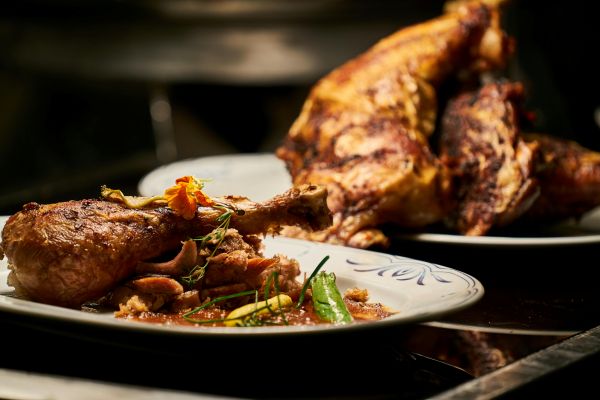How Many Meal Miles Have Turkeys Traveled?
Have you ever wondered how far your turkey has traveled before landing on your dinner plate? Whether preparing a holiday feast or enjoying a simple meal, the journey of an average turkey involves more miles than you might expect. But what does that mean for food costs, freshness, and sustainability?
In today’s globalized food system, the distance food travels—known as meal miles—plays a crucial role in determining its cost and environmental impact. With rising food costs affecting households nationwide, understanding where your turkey comes from can help you make more informed and cost-effective choices.
Meal Miles and Their Impact
When you sit down to enjoy a turkey dinner, have you ever considered how far that turkey has traveled to reach your plate? The journey from farm to table isn’t just about geography—it’s about food costs, sustainability, and the overall quality of what you eat.
What Are Meal Miles?
Meal miles refer to the total distance food travels from where it’s produced to where it’s consumed. This includes transportation from farms to processing facilities, then to distribution centers, grocery stores, and ultimately, your home. The greater the distance, the higher the environmental and economic costs.
Why Do Meal Miles Matter?
The miles your turkey racks up before arriving at your dinner table have significant implications. The farther food travels, the more expensive it becomes due to fuel, labor, and logistics. A turkey that has traveled long distances may also lose some of its natural moisture and flavor compared to a locally sourced one, affecting its freshness and quality. Additionally, transporting food across states or even countries increases carbon emissions, contributing to climate change.
The Hidden Costs of Long-Distance Food
Beyond the sticker price at the grocery store, meal miles impact costs in ways you may not immediately notice. Trucks, planes, and ships burn fossil fuels to transport food, adding hidden costs to the final price you pay. The longer food travels, the more refrigeration and packaging it requires, increasing costs and waste. Additionally, disruptions in transportation, such as fuel shortages or extreme weather, can lead to supply chain delays that unexpectedly drive up food costs.
The Journey of a Turkey: From Farm to Table
Have you ever thought about the incredible journey a turkey takes before it reaches your dinner plate? It’s not as simple as moving from farm to fork—there are several steps along the way that influence everything from freshness to food costs. Understanding this process can help you make more informed choices about the turkeys you buy.
Where Are Most Turkeys Raised?
In the United States, millions of turkeys are raised on large-scale farms, with major production hubs in states like Minnesota, North Carolina, and Arkansas. These farms focus on efficiency, raising turkeys in controlled environments to meet the high demand during peak seasons, especially around Thanksgiving and other holidays.
Processing and Packaging: What Happens Next?
Once turkeys reach the right size, they are transported to processing facilities where they are prepared for sale through plucking, cleaning, and packaging. They are then sorted by type, as fresh, frozen, organic, and conventional turkeys all require different handling processes. After sorting, they are shipped to distribution centers, which manage large quantities before sending them to grocery stores or restaurants.
How Far Does an Average Turkey Travel?
The number of meal miles a turkey accumulates depends on where it’s produced and where it’s purchased. On average, a store-bought turkey can travel 1,500 miles or more before landing in your kitchen. This distance is influenced by several factors, including supply chain complexity, as turkeys often move through multiple facilities before reaching a retailer. Retail demand also plays a role, with large grocery chains sourcing turkeys from different regions to meet consumer needs. Additionally, the type of turkey matters—fresh turkeys require faster shipping over shorter distances, while frozen ones can travel farther over time.
How Far Do Turkeys Travel?
When you pick up a turkey at the grocery store, you might not think about the miles it has traveled. But the distance from the farm to your plate affects everything from food costs to freshness. So, how far does the average turkey go before becoming the centerpiece of your dinner?
The Meal Miles of an Average Turkey
The journey of a turkey varies based on how and where it’s raised. On average, a store-bought turkey can travel 1,500 to 2,000 miles before reaching your home. This distance depends on several factors, including farm location, as most turkeys are raised in specific regions and often travel long distances to reach consumers in other states. Processing facilities also play a role, with large-scale plants sometimes located hundreds of miles from the farms where turkeys are raised. Once processed, turkeys are then shipped to warehouses before being distributed to grocery stores nationwide.
Local vs. National vs. Imported Turkeys
Not all turkeys travel the same distance. Here’s how different types compare:
Locally Raised Turkeys – Typically travel under 100 miles, offering the freshest option with fewer transportation costs.
Nationally Distributed Turkeys – Travel anywhere from 500 to 2,000 miles, depending on the farm and processing location.
Imported Turkeys – Less common, but in some cases, frozen turkeys can be shipped internationally, adding thousands of miles to their journey.
Why Do These Distances Matter?
The farther a turkey travels, the greater its impact on freshness, the environment, and cost. Long-distance transport requires extended refrigeration or freezing, which can affect the turkey’s texture and taste. Additionally, more miles mean a higher environmental footprint, as trucks, planes, and ships contribute to increased carbon emissions. Transportation, fuel, and storage expenses also add to the overall cost, ultimately influencing the price you pay at checkout.
The Hidden Costs of Long-Distance Turkey Transport
When you buy a turkey, you’re not just paying for the bird itself—you’re also covering the cost of its journey. From fuel consumption to supply chain expenses, every mile traveled adds to the final price tag. But beyond the financial impact, long-distance food transport affects the environment, food quality, and even your dining experience.
The Carbon Footprint of a Traveling Turkey
The farther a turkey travels, the more resources it consumes. Transporting turkeys across hundreds or even thousands of miles requires trucks, planes, and refrigeration units, all of which burn fossil fuels and release carbon emissions. To maintain freshness, turkeys must be kept at controlled temperatures during transport, increasing electricity and fuel costs. Additionally, longer transport times necessitate more protective packaging to prevent spoilage, leading to increased waste and greater environmental strain.
How Meal Miles Affect Food Costs
Longer transportation distances drive up the cost of your turkey dinner in several ways. Higher fuel prices directly impact transportation costs, which are then passed down to consumers. Labor and logistics also play a role, as more handling and shipping steps increase the final price at the grocery store. Additionally, extended storage times require extra refrigeration, and any spoilage during transport leads to lost products, further driving up food prices.
The Impact on Freshness and Nutrition
The journey of an average turkey doesn’t just affect cost—it also influences quality. Fresh turkeys that travel long distances may lose moisture over time, affecting texture and taste. Additionally, extended freezing and thawing can lead to nutrient loss, meaning your meal may not be as wholesome as you expect.
Reducing Meal Miles: Sustainable Choices for Consumers
Now that you know how far turkeys travel before reaching your dinner table, what can you do to minimize meal miles and make more sustainable choices? Fortunately, you have options that can help reduce food costs, support local farmers, and even improve the freshness of your meals.
Why Choose Locally Raised Turkeys?
Buying a locally sourced turkey can make a big difference. Locally raised turkeys travel significantly shorter distances, reducing transportation emissions and their environmental impact. Because they spend less time in transit, they retain more natural moisture and flavor, ensuring better freshness. While some local options may have a higher upfront price, you often save on hidden costs like transportation and extended storage, making them a cost-effective and sustainable choice in the long run.
How to Find Ethical and Sustainable Turkey Sources
Want to make a more conscious choice? There are several ways to source a turkey with fewer meal miles. Many local farms sell directly to consumers, offering fresh, pasture-raised turkeys. Farmers’ markets are another great option, as they often feature locally raised poultry that has traveled minimal distances. Checking grocery labels can also help, as you can look for indicators like “locally raised” or “pasture-raised” to identify shorter supply chains. Additionally, some Community-Supported Agriculture (CSA) programs provide direct access to farm-fresh turkeys, making it easier to support local agriculture.
Considering Alternatives with Lower Meal Miles
If finding a locally raised turkey isn’t an option, consider alternative proteins with a smaller carbon footprint. Heritage turkeys, often raised on smaller farms, typically travel less than mass-produced ones. Plant-based alternatives, such as lentil loaves or plant-based roasts, eliminate the meal miles associated with poultry altogether. Additionally, if a whole turkey isn’t necessary, buying a smaller cut from a local butcher or farm can be a more sustainable choice, reducing both food waste and transportation impacts.
Bringing Your Turkey Closer to Home
The journey your turkey takes before landing on your dinner table is longer than most of us realize. From the farm where it’s raised to the store where you buy it, every mile adds to food costs, impacts freshness, and increases its carbon footprint. But here’s the good news—you have the power to make more informed choices.
By considering where your turkey comes from, you can reduce meal miles, support local farmers, and even improve the quality of your dinner. Whether you opt for a locally raised turkey, explore sustainable alternatives, or simply become more mindful of food transport, every small step makes a difference.
So, the next time you’re planning a meal, ask yourself: How far has my food traveled? A shorter journey doesn’t just benefit the planet—it leads to a fresher, more flavorful, and more cost-effective turkey on your plate. After all, when it comes to food, closer is often better.










